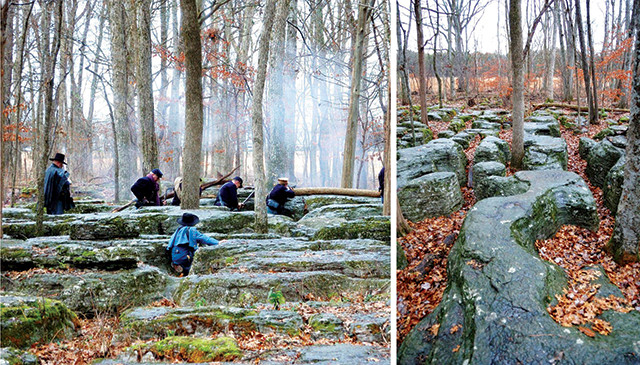
by David B. Williams Friday, June 17, 2016

As demonstrated here by Civil War reenactors in 2014, gaps naturally carved into limestone outcrops, called karrens or cutters, provided opportune defensive positions from which retreating Union forces staved off advancing Confederate soldiers while awaiting reinforcements during the Battle of Stones River (Tennessee) in December 1862. Credit: Scott P. Hippensteel and Geosphere.
About 10 years ago, Scott Hippensteel decided to trace the footsteps of an ancestor who fought in the Civil War at the Battle of Antietam near Sharpsburg, Md. His relative, William H. Tritt, fought with the Union in the 130th Pennsylvania Volunteer Infantry, which, on Sept. 17, 1862, attacked Confederate soldiers entrenched in the infamous Sunken Road, a wagon-worn dirt road atop an embankment that farmers used to bypass the town. As Hippensteel walked the rolling topography himself, he quickly realized the tactical advantage the landscape afforded: The Union men became visible to their enemies only in the last 150 meters or so of their approach. Because of the single-shot rifle technology of the time, each Confederate soldier would have only had time to fire a few shots at their attackers, facilitating a more vigorous assault by the Union. The Union forces suffered heavy losses in driving the Confederates from the Sunken Road, but their ultimate success pierced the middle of the Confederate line at Antietam and led to the roadway being renamed “Bloody Lane."
“This was the first time I had such a visceral experience of how geology affected battle plans,” says Hippensteel, a geologist at the University of North Carolina at Charlotte. Hippensteel began to look into how the geology underlying several prominent battlefields might have impacted the fighting at each. In a recent study published in Geosphere, he described the carbonate rocks beneath the battlefields at Antietam, Stones River, Chickamauga and others. Unlike most previous studies that have focused only on how geology influenced defensive tactics — most famously at Gettysburg — Hippensteel considered impacts on both offensive and defensive maneuvering.
No place better illustrates how geology influenced defensive strategy than the battlefield at Stones River in Tennessee, Hippensteel says, which he was able to walk during a reenactment of the fight. Seeing the reenactors “gave me a completely new perspective” on the role of the rocks there, he says.
During the three-day battle, nearly a third of the 80,000 combatants were killed, wounded or went missing. Underlying the entire area is the Ridley Limestone, a 30- to 45-meter-thick Middle Ordovician formation of cryptocrystalline to very fine-grained rock. Within the limestone are irregular layers of varying hardness, which have resulted in the weathering of sinkholes and karrens — parallel furrows or trenches 1 to 1.5 meters deep and roughly 1 meter wide — into the rock surface. The features are known locally as cutters.
The Confederates attacked on the morning of Dec. 31, 1862. Pushing across relatively flat, cultivated ground, they were initially able to drive the Union back to a forested area filled with cutters. “The Confederates were right at the point of victory, when the rocks turned around the battle,” Hippensteel says. In the forest, the Union soldiers were able to hole up within the outcropping limestone trenches, becoming almost invulnerable to attack. Protected by the rocks, the Union stalled the Confederate advance long enough for more troops to arrive, which helped turn the battle in favor of the Union.
Antietam, meanwhile, provided an excellent example of how geology influenced offense in battle. Several different limestone units underlay the battlefield in Maryland, leading to different topographies. The Elbrook Formation, for example, forms rolling terrain — a very rounded, high-relief landscape — as opposed to the undulating landscape created by the Conococheague Formation, which weathers into more gentle slopes that rise and fall over long distances. Undulations are good for defensive purposes because attackers have little cover and can be seen at great distances. In contrast, rolling terrain, including the area of the Sunken Road, aids attackers who can take advantage of the topography: They fire, quickly retreat behind a hillcrest, and then fire again on their enemy.
Ultimately, Hippensteel’s study suggests that the mantra that all politics are local also applies to how geology can shape combat. He found that casualties differed little overall among battles fought over a variety of geologic terrains, including limestone, noncarbonate rock and unconsolidated sediments. On large scales, advantages and disadvantages provided by carbonate rocks tended to cancel out each other, but on small, local scales, as illustrated so well at Antietam and Stones River, the geology could be a deciding factor in who won or lost.
© 2008-2021. All rights reserved. Any copying, redistribution or retransmission of any of the contents of this service without the expressed written permission of the American Geosciences Institute is expressly prohibited. Click here for all copyright requests.